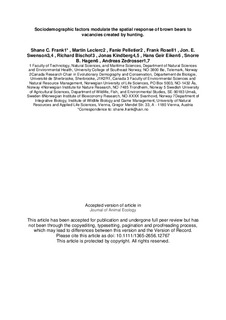Sociodemographic factors modulate the spatial response of brown bears to vacancies created by hunting
Frank, Shane C.; Leclerc, Martin; Pelletier, Fanie; Rosell, Frank; Swenson, Jon; Bischof, Richard; Kindberg, Jonas; Eiken, Hans Geir; Hagen, Snorre; Zedrosser, Andreas
Journal article, Peer reviewed
Accepted version
Permanent lenke
http://hdl.handle.net/11250/2474185Utgivelsesdato
2017Metadata
Vis full innførselSamlinger
Sammendrag
1. There is a growing recognition of the importance of indirect effects from hunting on wildlife populations, e.g. social and behavioural changes due to harvest, which occur after the initial offtake. Nonetheless, little is known about how the removal of members of a population influences the spatial configuration of the survivors.
2. We studied how surviving brown bears (Ursus arctos) used former home ranges that had belonged to casualties of the annual bear hunting season in southcentral Sweden (2007–2015). We used resource selection functions to explore the effects of the casualty's and survivor's sex, age and their pairwise genetic relatedness, population density and hunting intensity on survivors' spatial responses to vacated home ranges.
3. We tested the competitive release hypothesis, whereby survivors that increase their use of a killed bear's home range are presumed to have been released from intraspecific competition. We found strong support for this hypothesis, as survivors of the same sex as the casualty consistently increased their use of its vacant home range. Patterns were less pronounced or absent when the survivor and casualty were of opposite sex.
4. Genetic relatedness between the survivor and the casualty emerged as the most important factor explaining increased use of vacated male home ranges by males, with a stronger response from survivors of lower relatedness. Relatedness was also important for females, but it did not influence use following removal; female survivors used home ranges of higher related female casualties more, both before and after death. Spatial responses by survivors were further influenced by bear age, population density and hunting intensity.
5. We have shown that survivors exhibit a spatial response to vacated home ranges caused by hunting casualties, even in nonterritorial species such as the brown bear. This spatial reorganization can have unintended consequences for population dynamics and interfere with management goals. Altogether, our results underscore the need to better understand the short- and long-term indirect effects of hunting on animal social structure and their resulting distribution in space.
